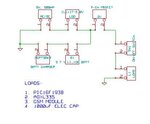speedEC
Full Member level 6
Dear all,
I need your help on selecting proper NTC THERMISTOR for our device to limit the inrush current. I have used 3.7v Li_ion Battery to power our device. I like to add NTC thermistor to limit the INRUSH CURRENT when the device is ON. I have tested using fixed 1.7 ohm resistor for limiting inrush current. It works fine. If I increased to 5.5 ohm resistor, the GSM Module won't register on Mobile Network because of insufficient current supply, I hope.
I give you brief details about the loads I used in our device and its voltage range.
LOADS:
1. SIM900B GSM Module - 3.2v to 4.8v (22 mA - operating current, idle - 1.5mA)
***Please note that it requires 2A (milliseconds period) when transmit burst happens (i.e. while voice/data transmission)
2. 1000uF Electrolitic Capacitor for suppling 2A to Module.
3. PIC MCU
4. ADXL335 SENSOR
Kindly help me on selecting proper NTC THERMISTOR to use in our device to limit the initial Inrush Current.
thank you
I need your help on selecting proper NTC THERMISTOR for our device to limit the inrush current. I have used 3.7v Li_ion Battery to power our device. I like to add NTC thermistor to limit the INRUSH CURRENT when the device is ON. I have tested using fixed 1.7 ohm resistor for limiting inrush current. It works fine. If I increased to 5.5 ohm resistor, the GSM Module won't register on Mobile Network because of insufficient current supply, I hope.
I give you brief details about the loads I used in our device and its voltage range.
LOADS:
1. SIM900B GSM Module - 3.2v to 4.8v (22 mA - operating current, idle - 1.5mA)
***Please note that it requires 2A (milliseconds period) when transmit burst happens (i.e. while voice/data transmission)
2. 1000uF Electrolitic Capacitor for suppling 2A to Module.
3. PIC MCU
4. ADXL335 SENSOR
Kindly help me on selecting proper NTC THERMISTOR to use in our device to limit the initial Inrush Current.
thank you

